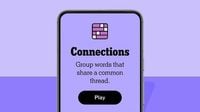Every morning, word game enthusiasts across the globe wake up to a new challenge from The New York Times—the Connections puzzle. On Saturday, August 9, 2025, players were greeted with a particularly intriguing quartet of categories, each demanding a distinct line of thought. The game, which has quickly gained traction since its launch, asks players to group sixteen seemingly unrelated words into four connected sets. The trick? Each group shares a hidden theme, and the difficulty increases as players move from yellow (easiest) to purple (most challenging).
According to The Economic Times, the August 9 puzzle delivered a mix of outcomes: some solvers breezed through the categories, while others found themselves stumped by clever wordplay and deceptive links. The answers, as reported by several outlets, were as follows: the yellow group (Result) included "fruit," "product," "return," and "yield"; the green group (Kinds of jokes) had "dad," "inside," "knock-knock," and "practical"; the blue group (Movies featuring supernatural romance) featured "Casper," "Ghost," "Let Me In," and "Twilight"; and the purple group (Corn-y things) comprised "maze," "muffin," "silk," and "syrup."
The yellow group, tagged as "Result," was perhaps the most straightforward for many players. Words like "fruit," "product," "return," and "yield" all share a common thread: each can represent an outcome or result of a process. As one Connections enthusiast noted on a fan forum, "It was a classic NYT move—using words that all mean 'what you get out of something.'" This group, marked by the yellow color, is often the easiest, serving as a warm-up for the more complex categories to come.
Moving on to the green group, the theme was "Kinds of jokes." Here, "dad," "inside," "knock-knock," and "practical" represent well-known joke formats, ranging from the groan-worthy puns of dad jokes to the elaborate setups of practical jokes. As The Economic Times put it, "Riddles are another type," offering a gentle nudge to players who might have been struggling. For many, recognizing the connection between these familiar forms of humor brought a welcome sense of relief amid the brain teasers.
The blue group, however, threw a curveball. Labeled "Movies featuring supernatural romance," it included "Casper," "Ghost," "Let Me In," and "Twilight." At first glance, these titles may not seem to belong together, but each is a film where romance and the supernatural intertwine. "Honestly, I didn't realize that the blue category was a movie genre, but now that I think about it, sure it is," wrote a reviewer at Tom's Guide. The blue group is often the most divisive—sometimes you see the link instantly, and sometimes you only understand it after the fact. In this case, players needed to connect the dots between ghostly love stories and vampire-human relationships, a testament to the puzzle's clever design.
Finally, the purple group, notorious for its difficulty, was themed "Corn-y things." The answers—"maze," "muffin," "silk," and "syrup"—are all related to corn, whether as parts of the plant or as corn-derived foods. The purple category often requires a leap in logic or a bit of lateral thinking, and this one was no exception. As Tom's Guide observed, "The purple group is usually very difficult. On the plus side, you don't technically need to solve the final one, as you'll be able to answer that one by a process of elimination." Still, for those who relish a challenge, cracking the purple code is the ultimate reward.
Behind the scenes, the Connections game is curated by associate puzzle editor Wyna Liu, whose knack for wordplay and thematic twists has made the game a daily ritual for many. Available on web browsers and mobile devices, Connections allows players up to four mistakes before the game ends. The interface lets users shuffle and rearrange words, encouraging fresh perspectives and new patterns. As The Economic Times explains, "Players must group four related words from a list of 16. Mistakes: Players can make up to four wrong guesses. Board Tools: Words can be rearranged and shuffled."
For those seeking to improve their performance, several tips have emerged from the puzzle community. Players are advised to look for obvious pairs before expanding to full groups, to use the shuffle function liberally, and to recall themes from previous puzzles. "Remember past puzzles to recognize recurring themes," suggests one seasoned solver. The game's color-coded difficulty system—yellow, green, blue, and purple—also serves as a guide, helping players prioritize which groups to tackle first.
In addition to the daily puzzle, the NYT has introduced a Connections Bot, similar to the one used for Wordle. Registered players can now track their progress, view their win rate, and even monitor their perfect score streaks. "Players who are registered with the Times Games section can now nerd out by following their progress," reports Tom's Guide. This gamification has only added to the competitive spirit, with social media feeds lighting up each morning as friends compare scores and strategies.
Connections is part of a broader trend in word games, following the viral success of Wordle and the enduring popularity of crosswords and other puzzles. Its unique twist—requiring not just vocabulary but associative thinking—has captivated a diverse audience. As Tom's Guide puts it, "NYT Connections is a word grouping game with difficulty levels indicated by colors: green (easy), yellow (harder), blue (tough), and purple (very difficult). Players can make up to four mistakes and solve the puzzle on desktop or mobile for free."
Saturday's puzzle (game #790) stands out not only for its clever categories but also for the way it brought together players of all ages and backgrounds. Whether you breezed through the "Result" group or found yourself scratching your head over "Corn-y things," the Connections puzzle once again proved its power to entertain, challenge, and connect—a fitting achievement for a game built on finding links where others see only chaos.





